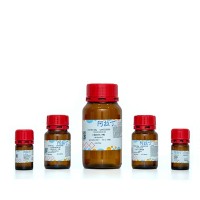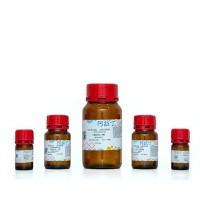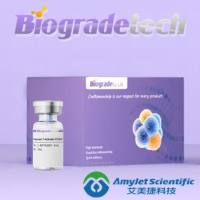Sample Preparation for Microinjection
互联网
Sample Preparation for Microinjection
To visualize and evaluate the success of a microinjection experiment these substances are typically mixed with dyes or labeled with fluorescent markers such as flourescein or rhodamine. After the capillary has pierced the cell, a certain amount of transfer substance (approximately 10% of the cell volume) is transferred from the capillary into the cell due to pressure exerted on the capillary via the microinjector [2 ]. Because the diameter of the capillary is very small, particles in the injection solution can quickly result in blockage of the capillary. Therefore, exchange of the capillary is a common practice during microinjection experiments and the frequency of the capillary exchange depends on the concentration and clarity of substance injected.
To maximize the number of injections which can be performed with a single capillary, the injection substance should be centrifuged for 10�15 minutes at a minimum of 10,000 x g before back loading the capillary. As the cross section of the capillary tip is small and very little liquid would be found there, it dries quickly and creates a blockage. Therefore, the filled capillary should be inserted into the capillary holder and immediately lowered into the medium to avoid blockage due to drying. The capillary should always remain in the medium especially during long experiments when large numbers of cells are injected.
In order that the open petri dish has a sufficient pH stability under the microscope, a carbonate-free medium must be used (e.g., “HEPES”, pH 7.4 buffered, 10 mmol/l). A 3 cm dish should be filled with at least 2 ml medium. Cultivation can still take place in the usual medium containing carbonate.
The speed and efficiency of automated systems allows biochemical analysis of microinjected cells. Between 500 and 1000 labeled cells are sufficient to analyze labeled proteins by gel electrophoresis.
Cultivation and Microinjection
Preparation [3]
- Plate 250 cells in 5 µl droplets in the center of a glass coverslip (10 x 10 mm).
- Place coverslips into a humid chamber and incubate at 37°C until cells attach to the glass (usually takes 6�8 hr).
- Transfer coverslips into 35 mm petri dishes containing 2 ml of culture medium and let cells grow for 2 days at 37°C. After this time, 500 to 1000 cells will usually be in the center of the coverslip.
- Microinject all cells on the coverslip.
- Proceed with biochemical analysis (depends on the particular experiment).
Note: For time series experiments, the cells may be plated directly on to Eppendorf® CELLocate gridded cover slips placed in the center of a glass slide. Thereby individual cells (55 µm) or cell groups (175 µm) can be located easily after microinjection. Eppendorf Micromanipulator 5179 and FemtoJet™ can be used with Femtotips and Femtotips II precision microcapillaries to efficiently perform cytoplasmic and nuclear microinjection on a wide range of adherent cells.
Proteins, Antibodies
Purification [4] Purification methods which result in the highest activity of the particular proteins or antibodies should be used. For peptide antibodies raised in rabbits, affinity purification is recommended. The concentration of the material injected should be 10 to 20 times higher than that required for the optimum in vitro activity, because the sample is diluted 10 to 20 times when injected into the cells.
Storage Purified antibodies must be stored in the concen-tration in which they arise. Shock freeze small aliquots of 5�10 µl in liquid nitrogen. Store at maximum temp. of �20°C (�80°C is even better). Azide should not be used.
Refrain from repeated freezing and defrosting as antibodies lose activity and start to agglutinate leading to blockages of the injection capillaries.
Defrosting should be performed as quickly and gently as possible.
Before loading the capillary, centrifuge material for 15 minutes at 4°C (10,000 x g ). Chill supernatant or load directly into capillary.
DNA [5]
Purification The highest expression level of microinjected plasmid DNA is achieved when the DNA has been purified by CsCl ethidium bromide gradient centrifugation in accordance with the Maniatis protocol [6] .
Dissolve DNA in bidist. water after purification.
Buffers, e.g., PB’s, are not recommended as this often leads to blockages of the capillaries.
DNA concentrations of 20 µg/ml to 200 µg/ml for plasmid DNA injection has been recommended [1] .
Storage Store at �20°C in small aliquots of 5�10 µl.
Defrosting should be performed as quickly and gently as possible.
Before loading the capillary, centrifuge material for 15 minutes at 4°C (10,000 x g). Chill supernatant or load directly into capillary.
Repeated centrifugation does not cause damage but is not necessary for each capillary filling when chilled with ice and used within an hour.
RNA Purification
Any standard protocol is suitable for purifying RNA solutions [6].
As for DNA, RNA is dissolved in bidist. water after purification.
Concentrations of 1�2 µg/ml should be used for mRNA and up to 10 µg/ml for total RNA.
Storage Store at �80°C in small aliquots of 5�10 µl.
For longer periods, it is advisable to dissolve and store the cleaned RNA in alcohol instead of water.
Defrosting should be performed as quickly and gently as possible.
Before loading the capillary, centrifuge material for min. 15 minutes at 4°C (10,000 x g ). Chill supernatant or load directly into capillary.
Only centrifuge and use each aliquot once.
Dyes, fluorescent injection markers [1]
Successful fluorescent injection markers used to identify and follow injected cells are: fluorescence labeled dextrans, antibodies, bovine serum albumin.
Dextran marked e.g. with rhodamine of a concentration of 2 µg/ml can be detected for up to 48 hours in the cell.
Fluorescein fades with time and results in harmful radicals, therefore markers should preferably be labeled with rhodamine.
Storage Store at �80°C in small aliquots of 5�10 µl.
Many solutions are sensitive to light. Thus, exposure to direct light should be avoided.
To avoid blocking of the capillary during microinjection, solutions containing the markers should be filtered with a syringe filter (pore size 0.2 µm) whenever possible. Also, before loading the capillary, the sample should be centrifuged for 15 minutes at 4°C (10,000 x g ).
Peptides
Please refer to the current literature for information on the cleaning and use of peptides.
A concentration of at least 5�10 µg/ml should be used for injection, because some peptides rapidly degrade in the cells after injection.
Oligonucleotides
Purification The purification of oligonucleotide solutions is very important. Cleaning with gel or HPLC is recommended.
Like DNA, oligonucleotides are dissolved in bidist. water after purification.
A concentration of 1�2 µg/ml should be used for injection of antisense oligonucleotides with 10�20 bases.
Note: Injected oligos accumulate easily in the nucleus.
Literature
[1] Pepperkok, R., Schneider, C., Philipson, L., and Ansorge, W. (1988). Single cell assay with an automated capillary microinjection system. Exp.Cell Res. 178, 369-376.
[2] Pepperkok, R., Scheel, J., Horstmann, H.,Hauri, H.P., Griffiths, G., and Kreis,T. E. (1993b). ß-COP is essential for biosynthetic membrane transport from the endplasmic reticulium to the Golgi complex in vivo. Cell 74, 71-82.
[3] Pepperkok, R., Saffrich, R., and Ansorge, W. (1994). Computer-Automated Capillary Microinjection of Macromolecules into Living Cells. Cell Biology: A Laboratory Handbook, CSH Laboratory Press
[4] Antibodies: A laboratory manual (1988). Harlow, E. and Lane, D. ed., CSH Laboratory Press.
[5] Proctor, G.N. (1992). Microinjection of DNA into mammalian cell in culture: Theory and practice. Methods Mol. Cell. Biol. 3, 209-231.
[6] Sambrook, Fritsch, Maniatis (1989). Molecular Cloning: A laboratory manual. CSH Laboratory Press.
We thank Dr. Rainer Pepperkok, Université de Genéve, Département de Biologie Cellulaire Sciences III, CH 1211 Genève 4, for providing us with data .







